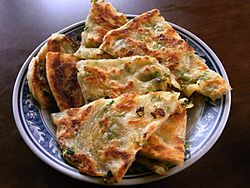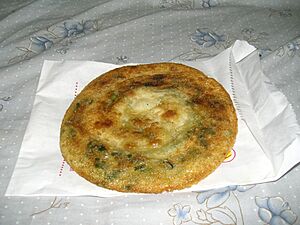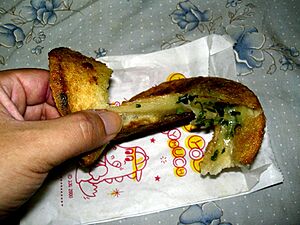Cong you bing facts for kids

Spring onion pancakes in Taichung (2013)
|
|
| Alternative names | scallion pancake |
|---|---|
| Type | Flatbread |
| Place of origin | China |
| Main ingredients | Dough, scallions |
| Cong you bing | |||||||||||||||||
|---|---|---|---|---|---|---|---|---|---|---|---|---|---|---|---|---|---|
| Traditional Chinese | 蔥 油 餅 | ||||||||||||||||
| Simplified Chinese | 葱 油 饼 | ||||||||||||||||
| Literal meaning | scallion oil pancake | ||||||||||||||||
|
|||||||||||||||||
Cong you bing (cōngyóubǐng) is a yummy Chinese food. It is also called a scallion pancake or "green onion pancake." This tasty dish is a type of flatbread from China.
It is made from dough, not a runny batter like regular pancakes. The dough is folded with oil and tiny pieces of scallions (green onions). Then, it is cooked in a pan until it gets crispy edges. The inside has many layers, making it chewy and fun to eat.
You can find scallion pancakes sold as street food or in restaurants. Many stores also sell them fresh or frozen in packages. You might see them in Asian supermarkets.
Contents
Different Kinds and What to Eat With Them
Sometimes, other tasty things are added to scallion pancakes. People might add chopped fennel greens or sesame seeds. These are mixed in with the green onions.
If garlic chives are used instead of scallions, the pancakes have a different name. They are called jiucai bing or jiucai you bing.
In Taiwanese cuisine, there is a special kind called egg pancakes (蛋餅). These pancakes are thinner and softer. An egg is cooked right onto one side of the pancake.
In North America, people often eat scallion pancakes with dipping sauces. Popular choices include soy sauce, spicy chili sauce, or Vietnamese dipping sauce.
A Fun Story: Did Scallion Pancakes Inspire Pizza?
There is a fun story in China about how pizza might have been invented. This story says that Marco Polo brought the idea of scallion pancakes back to Italy.
The story goes that Marco Polo really missed scallion pancakes when he was back home. He looked for chefs who could make them for him. One day, he met a chef from Naples. Marco Polo asked the chef to try making the pancake.
After trying for a long time, the chef couldn't get it right. So, Marco Polo suggested putting the filling on top of the dough instead of inside. Everyone at the party loved this new dish! The chefs went back to Naples and added cheese and other ingredients. This, the story says, became today's pizza.
However, history tells us that pizza was around in Europe long before Marco Polo was born. The word "pizza" was first used in a Latin text in 997 AD. This was more than 250 years before Marco Polo's time. So, it seems the similarity between pizza and scallion pancakes is just a coincidence. Both are types of flatbread.
Other Yummy Flatbreads Around the World
Many cultures have dishes that are similar to scallion pancakes. Here are a few:
- China
- Elsewhere
See also
 In Spanish: Pan de cebolleta para niños
In Spanish: Pan de cebolleta para niños



